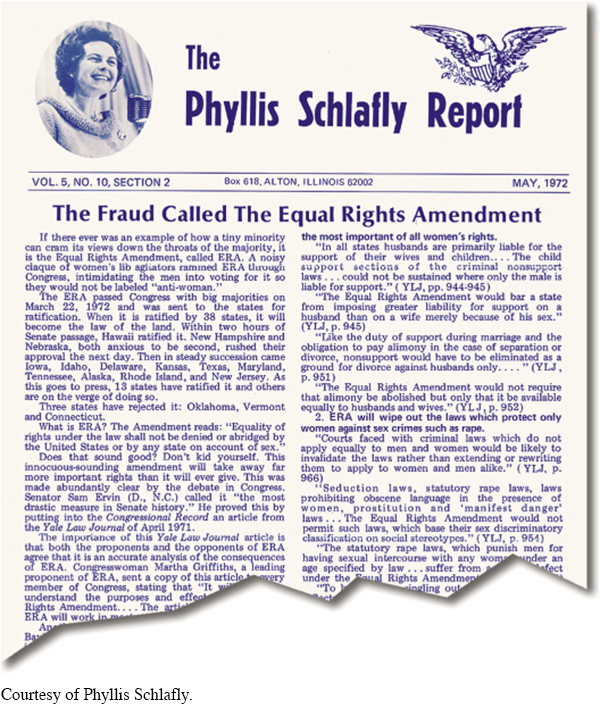The American Promise: Printed Page 861
The American Promise, Value Edition: Printed Page 779
The American Promise: A Concise History: Printed Page 890
Introduction to Chapter 30
The American Promise: Printed Page 861
The American Promise, Value Edition: Printed Page 779
The American Promise: A Concise History: Printed Page 890
Page 86130
America Moves to the Right
1969–

CONTENT LEARNING OBJECTIVES
After reading and studying this chapter, you should be able to:
Explain the emergence of a grassroots conservative movement and how Nixon courted the right. Identify the events that led to Nixon’s resignation.
Describe the “outsider” presidency of Jimmy Carter and explain his approach to energy and environmental regulation, human rights, and the Cold War.
Explain how Ronald Reagan’s presidency represented ascendant conservatism and the factors behind Reagan’s broad appeal.
Explain how minority groups, feminists, gays and lesbians, and lower-
income Americans struggled during the 1980s. Describe Reagan’s foreign policies, including increased militarization and interventions in the Middle East, Latin America, and Asia. Explain what led to a thaw in Soviet-
American relations.
ONE OF THE “MOST EXCITING DAYS” OF PHYLLIS SCHLAFLY’S life was hearing Republican Barry Goldwater address the Federation of Republican Women in 1963. Schlafly wanted the United States to do more than just contain communism; like Goldwater, she wanted to eliminate that threat entirely. She also wanted to cut back the federal government, especially its role in providing social welfare and enforcing civil rights. Goldwater’s loss to Lyndon Johnson in 1964 did not diminish Schlafly’s conservative commitment. She added new issues to the conservative agenda, cultivating a grassroots movement that would redefine the Republican Party and American politics well into the twenty-
Phyllis Stewart was born in St. Louis in 1924, attended Catholic schools, and worked her way through Washington University testing ammunition at a World War II defense plant. After earning a master’s degree in government from Radcliffe College, she worked at the American Enterprise Institute, where she imbibed the think tank’s conservatism. Returning to the Midwest, she married Fred Schlafly, an Alton, Illinois, attorney, and bore six children. “I don’t think there’s anything as much fun as taking care of a baby,” Schlafly claimed.
The American Promise: Printed Page 861
The American Promise, Value Edition: Printed Page 779
The American Promise: A Concise History: Printed Page 890
Page 862Yet while insisting that caring for home and family was women’s most important career, Schlafly spent much of her time writing or on the road, speaking, leading Republican women’s organizations, and testifying before legislative committees. She ran twice for Congress but lost in her heavily Democratic district in Illinois. Her 1964 book, A Choice Not an Echo, pushed Barry Goldwater for president and sold more than three million copies. In 1967, she began publishing the Phyllis Schlafly Report, a monthly newsletter about current political issues. Throughout the 1950s and 1960s, Schlafly advocated stronger efforts to combat communism, a more powerful military, and limited government action in domestic affairs.

In the 1970s, Schlafly expanded the agenda of conservatism to address new issues such as feminism, abortion, gay rights, busing for racial integration, and religion in the schools. Her ideas resonated with Americans who were fed up with the expansion of government, liberal Supreme Court decisions, protest movements, and the loosening of moral standards that seemed to define the 1960s. Although Richard Nixon did not embrace the entire conservative agenda, he won the presidency in 1968 on a platform that sought to make the Republicans the dominant party by appealing to disaffected blue-
Consequently, Schlafly’s call for “a choice not an echo” was realized when Ronald Reagan won the presidency in 1980. Cutting taxes, government regulations, and social programs; expanding the nation’s military capacity; and pressuring the Soviet Union and communism in the third world, Reagan addressed the hopes of the traditional right. Like Schlafly, he also championed the concerns of Christian conservatives, opposing abortion and sexual permissiveness and favoring a larger role for religion in public life.
In the face of resistance from feminists, civil rights groups, environmentalists, and others, Reagan failed to enact the entire conservative agenda. Although he enormously increased the national debt, and his aides engaged in illegal activities to thwart communism in Latin America, his popularity boosted the Republican Party. And Reagan’s optimism and spirited leadership contributed to a revival in national pride and confidence.
CHRONOLOGY
| 1968 |
|
| 1969 |
|
| 1971 |
|
| 1972 |
|
| 1974 |
|
| 1976 |
|
| 1977 |
|
| 1978 |
|
| 1979 |
|
| 1980 |
|
| 1981 |
|
| 1983 |
|
| 1984 |
|
| 1986 |
|
| 1987 |
|
| 1988 |
|